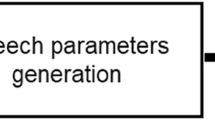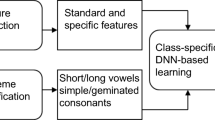Abstract
This paper investigates the use of deep neural networks (DNN) for Arabic speech synthesis. In parametric speech synthesis, whether HMM-based or DNN-based, each speech segment is described with a set of contextual features. These contextual features correspond to linguistic, phonetic and prosodic information that may affect the pronunciation of the segments. Gemination and vowel quantity (short vowel vs. long vowel) are two particular and important phenomena in Arabic language. Hence, it is worth investigating if those phenomena must be handled by using specific speech units, or if their specification in the contextual features is enough. Consequently four modelling approaches are evaluated by considering geminated consonants (respectively long vowels) either as fully-fledged phoneme units or as the same phoneme as their simple (respectively short) counterparts. Although no significant difference has been observed in previous studies relying on HMM-based modelling, this paper examines these modelling variants in the framework of DNN-based speech synthesis. Listening tests are conducted to evaluate the four modelling approaches, and to assess the performance of DNN-based Arabic speech synthesis with respect to previous HMM-based approach.
Access this chapter
Tax calculation will be finalised at checkout
Purchases are for personal use only
Similar content being viewed by others
References
Abdel-Hamid, O., Abdou, S.M., Rashwan, M.: Improving Arabic HMM based speech synthesis quality. In: 9th International Conference on Spoken Language Processing, INTERSPEECH 2006, Pittsburgh, Pennsylvania (2006)
Al-Ani, S.H.: Arabic Phonology: An Acoustical and Physiological Investigation, vol. 61. Walter de Gruyter, Berlin (1970)
Bengio, Y.: Learning deep architectures for AI. Found. Trends® Mach. Learn. 2(1), 1–127 (2009)
Black, A.W., Zen, H., Tokuda, K.: Statistical parametric speech synthesis. In: International Conference on Acoustics, Speech and Signal Processing, ICASSP 2007. vol. 4, pp. IV–1229. IEEE (2007)
Fan, Y., Qian, Y., Xie, F.L., Soong, F.K.: TTS synthesis with bidirectional LSTM based recurrent neural networks. In: 15th Annual Conference of the International Speech Communication Association, Singapore (2014)
Halabi, N.: Modern standard Arabic speech corpus. Ph.D. thesis, University of Southampton (2015)
Houidhek, A., Colotte, V., Mnasri, Z., Jouvet, D., Zangar, I.: Statistical modelling of speech units in HMM-based speech synthesis for Arabic. In: 8th Language & Technology Conference, LTC 2017, Poznan, Poland (2017)
Hunt, A.J., Black, A.W.: Unit selection in a concatenative speech synthesis system using a large speech database. In: International Conference on Acoustics, Speech, and Signal Processing Conference Proceedings, ICASSP 1996, vol. 1, pp. 373–376. IEEE, Atlanta (1996)
ITU: 800, methods for subjective determination of transmission quality. International Telecommunication Union (1996)
Jurafsky, D.: Speech and language processing: an introduction to natural language processing. In: Computational Linguistics, and Speech Recognition (2000)
Kawahara, H., Masuda-Katsuse, I., De Cheveigne, A.: Restructuring speech representations using a pitch-adaptive time-frequency smoothing and an instantaneous-frequency-based F0 extraction: possible role of a repetitive structure in sounds. Speech Commun. 27(3), 187–207 (1999)
Khalil, K.M., Adnan, C.: Arabic HMM-based speech synthesis. In: International Conference on Electrical Engineering and Software Applications, ICEESA 2013, pp. 1–5. IEEE, Hammamet (2013)
Krstulovic, S., Hunecke, A., Schröder, M.: An HMM-based speech synthesis system applied to German and its adaptation to a limited set of expressive football announcements. In: 8th Annual Conference of the International Speech Communication Association, pp. 1897–1900. Citeseer, Antwerp (2007)
Maguer, S.L., Barbot, N., Boeffard, O.: Evaluation of contextual descriptors for HMM-based speech synthesis in French. In: 8th Workshop on Speech Synthesis, Barcelona, Spain (2013)
Morise, M., Yokomori, F., Ozawa, K.: WORLD: a vocoder-based high-quality speech synthesis system for real-time applications. IEICE Trans. Inf. Syst. 99(7), 1877–1884 (2016)
Newman, D.: The phonetic status of Arabic within the world’s languages: the uniqueness of the lughat al-daad. Antwerp Pap. Linguist. 100, 65–75 (2002)
Selouani, S.A., Caelen, J.: Arabic phonetic features recognition using modular connectionist architectures. In: Proceedings of the IEEE 4th Workshop on Interactive Voice Technology for Telecommunications Applications, IVTTA 1998, pp. 155–160. IEEE, Torino (1998)
Tokuda, K., Zen, H., Black, A.W.: An HMM-based speech synthesis system applied to English. In: IEEE Speech Synthesis Workshop, Santa Monica, CA, USA, pp. 227–230 (2002)
Watts, O., Henter, G.E., Merritt, T., Wu, Z., King, S.: From HMMS to DNNs: where do the improvements come from? In: International Conference on Acoustics, Speech and Signal Processing, ICASSP 2016, pp. 5505–5509. IEEE, Lujiazui (2016)
Wu, Z., Watts, O., King, S.: Merlin: an open source neural network speech synthesis system. In: Proceedings of the SSW, Sunnyvale, USA (2016)
Zangar, I., Mnasri, Z., Colotte, V., Jouvet, D., Houidhek, A.: Duration modeling using DNN for Arabic speech synthesis. In: 9th International Conference on Speech Prosody, Poznan, Poland, pp. 597–601 (2018)
Zen, H.: Deep learning in speech synthesis. In: SSW, Barcelona, Spain, p. 309 (2013)
Zen, H., Senior, A., Schuster, M.: Statistical parametric speech synthesis using deep neural networks. In: International Conference on Acoustics, Speech and Signal Processing, ICASSP 2013, pp. 7962–7966. IEEE (2013)
Zen, H., Tokuda, K., Masuko, T., Kobayasih, T., Kitamura, T.: A hidden semi-Markov model-based speech synthesis system. IEICE Trans. Inf. Syst. 90(5), 825–834 (2007)
Zhang, M., Tao, J., Jia, H., Wang, X.: Improving HMM based speech synthesis by reducing over-smoothing problems. In: 6th International Symposium on Chinese Spoken Language Processing, ISCSLP 2008, pp. 1–4. IEEE, Kunming (2008)
Acknowledgements
This research work was conducted under PHC-Utique Program in the framework of CMCU (Comité Mixte de Coopération Universitaire) grant N 15G1405.
Author information
Authors and Affiliations
Corresponding author
Editor information
Editors and Affiliations
Rights and permissions
Copyright information
© 2018 Springer Nature Switzerland AG
About this paper
Cite this paper
Houidhek, A., Colotte, V., Mnasri, Z., Jouvet, D. (2018). DNN-Based Speech Synthesis for Arabic: Modelling and Evaluation. In: Dutoit, T., Martín-Vide, C., Pironkov, G. (eds) Statistical Language and Speech Processing. SLSP 2018. Lecture Notes in Computer Science(), vol 11171. Springer, Cham. https://doi.org/10.1007/978-3-030-00810-9_2
Download citation
DOI: https://doi.org/10.1007/978-3-030-00810-9_2
Published:
Publisher Name: Springer, Cham
Print ISBN: 978-3-030-00809-3
Online ISBN: 978-3-030-00810-9
eBook Packages: Computer ScienceComputer Science (R0)




